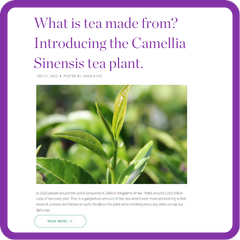About tea
Kitchen cupboards in New Zealand are typically stocked with three types of tea - English Breakfast, Earl Grey and a generic green tea, in addition to herbal infusions. It's an exciting fact that the world of tea goes well beyond these narrow, English-inspired choices. Here, we help you gain a simple understanding of the full world of tea.
What is tea?

All tea comes from the tea plant – Camellia Sinensis (pictured). This plant is native to both China (Camellia Sinensis var. Sinensis) and India (Camellia Sinensis var. Assamica).
There are six categories of tea - some well-known, such as green and black tea, others less so. These are:
1. White
2. Green
3. Yellow
4. Oolong
5. Black
6. Dark (also known as fermented or pu'erh)
Each of the six types of tea starts the same way - from the harvested leaf of the Camellia Sinensis tea plant. The difference between the six types comes from the processing steps that the leaves undergo after they’re plucked, in particular oxidation - a natural process that changes the leaves' chemistry when they are gently bruised. The processing steps change the chemical make-up inside the leaf, which then changes the colour and flavour of the tea, and determine which of the six categories the tea fits into.
Here's a simplified diagram to explain it visually.

As you can see above, white tea is the least processed as the leaves are simply plucked and dried, and as a result, it has the lightest colour, body and flavour. The following five types have additional and more complex processing steps and therefore deeper colours, body and flavour. White tea looks and tastes very different to black tea for example - and that's simply because black tea is fully oxidised, heated and rolled, and white tea isn't.
What about herbal 'tea'?
If the leaves/dried plant in your tea pot or tea bag aren’t from Camellia Sinensis then it isn’t tea and really, shouldn’t be named so. Peppermint 'tea' and Chamomile 'tea' for example, should be called an infusion or tisane, rather than tea. Find out more about why we mistakenly call these infusions tea.
Specialty tea vs. mainstream tea
Like most products, tea comes in a large range of qualities and price points. Sitting at the mid-to-top end of the tea spectrum is specialty tea. Specialty tea covers the broad category of tea that is produced in the traditional way (the six types of tea mentioned above all fit in here). It is also known as ‘artisan tea’, ‘pure-leaf tea’ or ‘orthodox tea’. A lot of technical craft and care goes into producing specialty tea. The final, crafted tea has a high level of flavour complexity which often changes each year depending on environmental changes such as rainfall (similar to wine) and is typically produced in relatively small batches. It is sold by specialist tea boutiques and online retailers and is almost always loose-leaf. It can be hard to find in New Zealand. Here at The Tea Curator, this is our area of expertise and we only stock specialty tea.
What you will typically find in the supermarket is tea generally produced by the ‘cut, tear curl’ method (known in the industry as ‘CTC’). This is used by large tea producers for well-known tea brands. Out of the six types of tea, it is predominately used to produce black tea (but sometimes green) on a large scale at a cost-effective price. CTC tea sits at the mid-to-bottom end of the spectrum and is loose-leaf and packed in tea bags. It is typically produced and blended to achieve the same flavour profile year after year.
How to enjoy your tea
If you choose to drink specialty tea, you will have a wonderful experience if are curious, open-minded and to adopt an adventurous palette, as the flavours you experience may be unfamiliar and different to what you are used to. But once the doors are open, this curiosity will lead you to a lifetime of fascinating and nourishing tea experiences.
There is an art to preparing specialty tea, which, when followed, allows you to draw out its best flavour. If you make the choice to drink specialty tea, its worth learning how to steep your precious leaves and to also create your own, personalised tea ritual.
Six steps to steeping your tea

1) Water. Use freshly drawn, cold (ideally filtered) water as this will bring out the best of your tea’s aromas and flavours.
2) Measure. A good rule of thumb is around 2.5 – 3 grams (one heaped teaspoon) of loose leaves, to a standard tea cup (130 – 150 mls). As specialty tea varies in shape, ideally use a scale.
3) Temperature. The right temperature will help you activate the aromatic oils in your leaves without scorching the tea or turning it bitter. If you don’t have a temperature-variable kettle (highly recommended!), open the lid and let the boiled water cool for 30s for black tea, 1.5 mins for dark tea, 2 mins for dark oolong and 2.5 mins for white, green, yellow and light oolong. Or add a splash of cold water when you pour boiling water over the leaves.
4) Time. Different teas often suit different steeping durations (which should be stated on your tea's packaging). Use your smart-phone timer and your delicate leaves will never turn bitter.
5) Steep. High quality, full leaf teas can always be steeped at least twice. Infusing multiple times allows you to detect subtle changes in flavour and your precious leaves will last longer.
6) Store. If kept well, tea can retain its aroma and flavour for between one and three years and sometimes beyond. It loves to be stored in a dark, airtight canister away from heat, humidity, moisture and strong smells such as spices.
How to taste your tea

Look. Observe the shape, texture, colour of the leaves and whether there are any buds. This gives you a first impression of the tea's flavour.
Smell. To help you understand what flavours and aromas you will find in your cup, smell the dry leaves, the wet leaves and then the poured tea (‘the liquor’).
Taste. When you take a sip of your tea, breathe in at the same time, then breathe out through your nose while holding the liquor in your mouth and then after swallowing. While the taste buds on your tongue allow you to taste the liquor, breathing out will draw the aroma through your throat and up to your olfactory gland. Doing both gives you a full appreciation of the tea's flavour.
Sense. The brief, fleeting flavours you immediately perceive are called ‘head notes’. When you hold the liquor held in your month, you will taste the ‘body notes’. And finally, after you have swallowed the liquor, you will notice the aftertaste or ‘tail notes’. Pay attention to how the texture of the tea feels in your mouth. Is it soft and smooth, or rough and dry? If it leaves a dry sensation in your mouth, it has a higher tannin content and can be described as astringent.
Describe. Use words to describe the flavours and aromas you can detect (using the flavour wheel below as a guide) as well as how weighty it feels in your mouth (light, medium, full) and the tea's 'mouthfeel'.

Tea flavour wheel COPYRIGHT© Australian Tea Masters.
How to choose a tea you'll like
If you're new to specialty tea, it can be hard to know where to start. Check out our simple tea selection guide to get you started, browse our loose leaf tea collection, or you can leave it in our capable hands by signing up to our monthly tea subscription and we'll choose for you.
Take your tea knowledge further
Our founder Anna loves hearing from fellow tea lovers, so please email her if you have any questions about tea.
Anna's blog also includes an abundance of unique and interesting information about tea:
This summary of tea, the blog content, and all of the information on our website, is the result of many hours of learning and work by our founder Anna Kydd, and is subject to COPYRIGHT © The Tea Curator 2022. Thank you for respecting this.



























